Christiane Gruber
Mosque and grove, ancient wall and garden, palace and courtyard, are full of song, of the cheerful sound of twittering and chirping; everywhere there is the rush of wings, everywhere the busy, active little lives go on.[1]
—Edmondo de Amicis (1878)
In Istanbul and further afield, a number of Ottoman mosques have been chirping away for centuries. Their stone walls emit the rustle and call of the birds that perch on their domes, sit on their ledges, and take up residence in Lilliputian edifices whose forms mimic the built environment of the humans ambling below (Fig. 1). These purpose-built microarchitectural birdhouses were a staple of eighteenth-century mosque construction in particular.[2] Although they are a prominent feature of late Ottoman architecture in Istanbul, such avian domiciles were made elsewhere in centuries prior; indeed, the oldest exemplar, located in Sivas, dates to the thirteenth century, and another birdhouse adorns the Ulu Cami (Great Mosque) of Tokat, built in 1380.[3] Unlike their predecessors, the eighteenth-century micro-structures display undulating architectonic forms and exuberant sculptural styles that place many of them squarely within the Ottoman baroque, a “new style” (tarz-ı nev) that creatively combined both local and global architectural traditions while also making reference to the natural environment.[4]
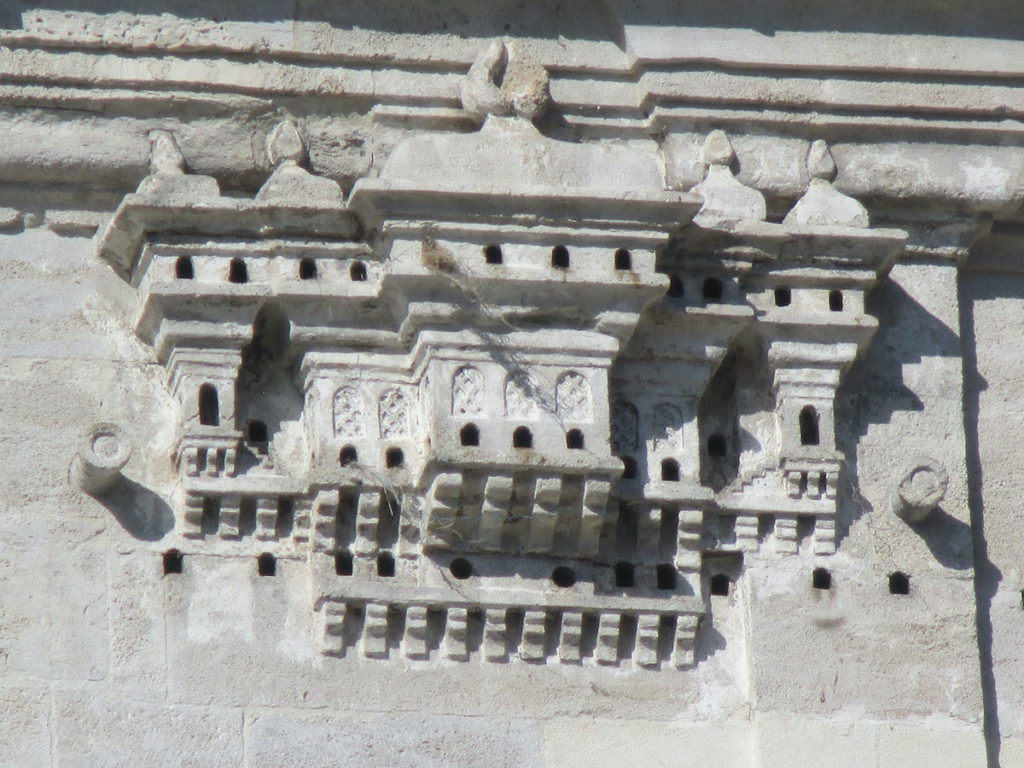
The terms of reference, however, did not halt there. Ottoman birdhouses transcend both model and miniature, man and nature, to act as fantastical structures whose major metaphor is the avian world itself. Not infrequently affixed to the qibla walls of mosques—which direct devotees towards the Ka‘ba, God, and thus salvation—these small but impressive structures also appear to give form to the famous hadith (saying) of the Prophet Muhammad: “There would enter Paradise people whose hearts would be like those of birds.”[5] As a consequence, these structures can act as a material allegory or textual exegesis, a function of microarchitecture that is a hallmark of medieval Western European artistic traditions as well.[6] Flying high and packed with the promise of enduring life, these soaring pavilions and their feathered inhabitants construct a larger devotional soundscape that blends the oral prayers of humans with the wafting arias of birds. As a result, mosques do not just act as “sound boxes”[7] for the melodic rendition of the Qur’an; they also reverberate in avian crooning and warbling. In such contact zones, species meet in salutation of God—and in the companionship of one another.[8]
Skirting an instrumentalized form of anthropocentrism, Ottoman birdhouses were not made for humans to collect bird eggs, to gain access to comestible animal flesh, or to amass nitrogen-rich droppings for use as agricultural manure, as was the case with the dovecotes of Cappadocia and the pigeon towers of Iran.[9] Unlike the latter, Ottoman birdhouses in Istanbul and throughout Ottoman lands were not used for agricultural or transactional purposes. Instead, they provided safe havens for sparrows, swallows, pigeons, and doves to come and go, free as the wind. While acting as architectural materializations of no-strings-attached human charity, these structures and their hollows offered birds—known in Arabic as tayr, or “winged” or “flying” entities[10]—a protected area or living sanctuary. This refugium is known in Arabic as a hima, a concept related to the environmental commons that stretches all the way back to the early Islamic period. Today’s environmentalists in Muslim majoritarian countries draw upon the hima rhetoric to craft their own contemporary ecological ethics within an overarching Islamic worldview based on human-nature custodianship and harmony.[11] This intersubjectivity bears larger implications for what Félix Guattari calls a “bioethical paradigm,”[12] to which Ottoman birdhouses contribute new frameworks and models of inquiry.
Providing this type of refugium may have been deemed a necessary act of compassion during the eighteenth century, when the Ottoman capital city was expanding and therefore encroaching upon the natural abodes of birds. At a time when forests, groves, and estuaries were increasingly pressed upon by urban development, these small structures may have acted as architectonic expiation for trees cut and cleared by man, of marshlands sliced through human enterprise. Whether this was the case or not, Ottoman birdhouses craft an avian ethology in minute architectural form, offering homes and waystations for their winged occupants. As bird populations collapse across the world today, these premodern micro-structures also suggest an alternative, non-Euro-American ethical position that antedates the moral imperatives precipitated by the Age of the Anthropocene. Instead, they articulate an ethics of engagement with nonhuman others—including birds, trees, and nature—while concurrently embracing a multisensorial aesthetics of delight typical of the eighteenth century in particular.
Aviaries of the Flesh and Mind
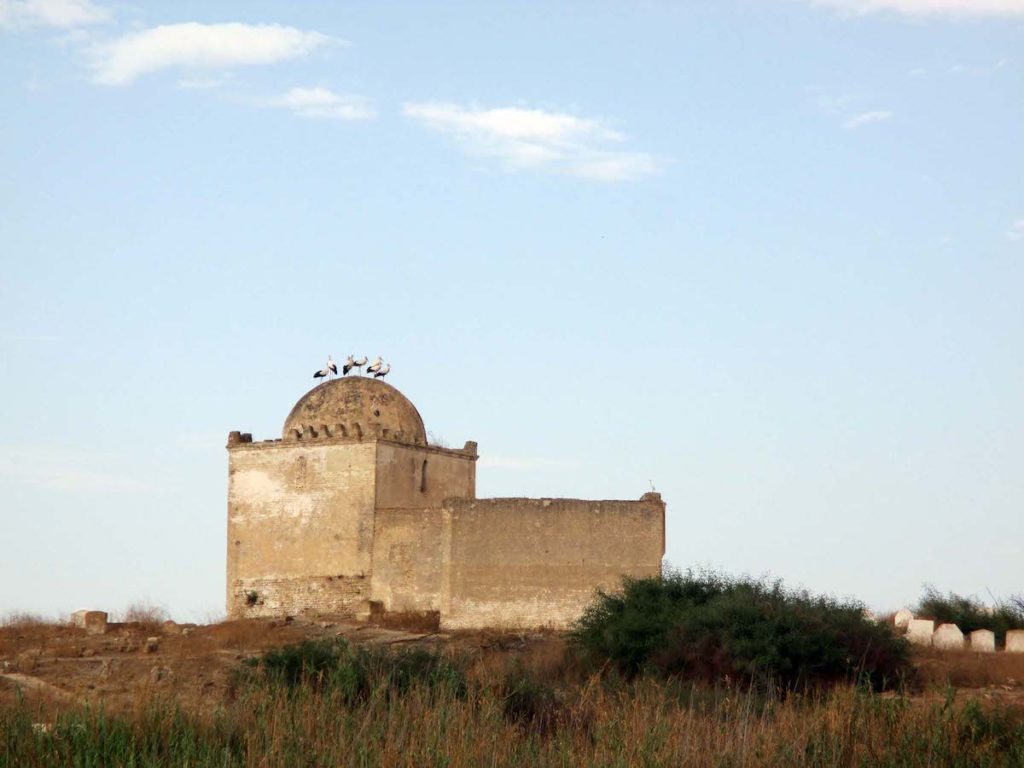
Going back centuries, birds have long inhabited the palaces and mosques of Muslim dynasts. At times, their shelters are unplanned and impromptu, comprising accidental nooks and crannies between bricks, stones, and wooden beams. Even the domes of mosques and roofs of minarets may inadvertently provide elevated platforms for the construction of stork nests, the birds and their babies appearing as if moving and singing architectural ornaments (Fig. 2). Besides the possible inability of reaching these lofty nests, building owners and mosque superintendents seem to have chosen not to clear them, a preservation drive suggestive of the perceived inherent virtue in interspecies cohabitation.
Some contemporary Muslim activist writers, such as Ibrahim Abdul-Matin, have explained this harmony as a reflection of Islam’s long-lasting ecological orientation—that is, of Islam as a “Green Deen” (“Deen” being an anglicization of Arabic din, or “religion”) that puts emphasis on the oneness of creation (tawhid), proper stewardship (khilafa) of the earth, protection (amana) of the planet, and living in balance (mizan) with nature.[13] To Abdul-Matin’s framework can also be added the premodern metaphysical doctrine of the “unity of being” (wahdat al-wujud), which posits divine existential unity.[14] This monistic position stipulating that God and all created beings are ontologically one was especially popular in Sufi circles. It may thus have energized the creation of birdhouses, which brought humans and animals together into a larger oneness of existence.
Crafting novel anthropo-avian settings, patrons and architects built purpose-made shelters to attract and maintain birds within their midst. Already during the tenth century, textual sources inform us that the Abbasid palaces in Samarra included walled gardens to protect plants and flowers from the hot, sandy winds of Iraq. The Balkuwara Palace included domesticated animals raised in reserves, fish ponds, and aviaries,[15] while the Jawsaq al-Khaqani Palace, also in Samarra, included bird-shaped automata. While visiting al-Muqtadir (r. 903-32) in the latter royal residence, Byzantine ambassadors were left astounded when he “gave out the order for the opening of the cupola (qubba) and the working of the tree, which came out of the ground by means of various mechanical devices until it filled the cupola. The fountains (fawwarat), gushing forth rose-water and musk, were turned on, and the figurines (tamathil) of birds perching on the tree chirped.”[16] Except for cacophonous crows, birds were already such a desideratum in early Islamic architectural complexes that ingenious contraptions were invented in order to magnify their perceived physical and sonic presence. Concurrently, they bewildered the human senses, causing awe (‘ajab) as well as an inability to distinguish truth from artifice.[17]
Like their predecessors, members of the Ottoman dynasty (c. 1299-1922) also showed a keen interest in the animal world. Falconry and horsemanship were royal prerogatives, while the gifting of elephants, lions, and even a rhinoceros formed part of diplomatic exchanges.[18] Birds, too, were included in zoological gift packages up until the turn of the twentieth century.[19] Within their palatial quarters, Ottoman sultans built aviaries to house both local and exotic birds, including fancy pigeons and dazzling peacocks. Their assemblages of avian specimens became so extensive that by the 1880s, a register (defter) was drawn up to record all the birds and other animals held in the Yıldız Palace and other locations in Istanbul, attesting to Sultan Abdülhamid II’s particular love of animals.[20] This defter includes several pages of what can be best described as a bird concordance, with columns of detailed information recording the name of a palace, kiosk, pavilion, or pool along with its number and genera of birds. Thus collated, this Ottoman royal zoological Wunderkammer numbered 6,671 birds in total, including, most prominently, doves, pheasants, canaries, peacocks, nightingales, partridges, crows, geese, and swans.[21]
Within the palaces and gardens of Topkapı, Yıldız, Beylerbeyi, and elsewhere, the birds’ tweets and purls meandered alongside the gush of running water to generate a soundscape that assuaged the strict silence imposed by court protocol.[22] As Nina Ergin highlights, during the seventeenth century the Topkapı Palace’s third courtyard housed both a bubbling fountain and large aviary, where “birdsong and water together formed a background soundtrack to the soaring, unearthly sounds of the recited Qur’an.”[23] As was the case for the city’s coeval mosques that included birdhouses on their qibla walls, Ottoman palace grounds—whose human occupants and visitors otherwise upheld decorous taciturnity—were enlivened by a viva voce mix of Qur’anic and avian invocations.
Beyond palace walls, within Islamic literary spheres the bird frequently serves as a trope to represent the soul’s flight to, and final uniting with, God. The soul is conceptualized as a winged entity, a tayr untethered from a corporeal cage, and from gravity itself. Many texts of a more spiritualist bent embrace this avian metaphor, two of which are worthy of brief mention here. The first is Ibn Sina’s (d. 1037) Risalat al-Tayr (Epistle of the Birds), which counsels its reader, “if you are prevented for want of wings then seek requital and you will fly. For the best of heralds are those which are able to fly.”[24] Two centuries later, the Persian Sufi poet ‘Attar (d. 1221) penned his Mantiq al-Tayr (The Conference of the Birds), a tale in which birds act as a metaphor for men who pursue the Sufi path towards unity (tawhid) with God.[25]
Beyond these Arabic and Persian classics, the turtledove and ringdove (güvercin) as well as the nightingale (bülbül) have held a prominent place in Ottoman and modern Turkish poetry.[26] In a versified imaginary they nest and sing among flowers and trees, symbolizing the love of couplehood both gained and lost. Like poets, rulers did not shy away from avian metaphors and their affective domains. For instance, Sultan Süleyman the “Magnificent” (r. 1520-1566) himself penned a love-song in which he compares his beloved wife Hürrem Sultan (also known as Roxelana) to a dove:
The time of the singing of birds is come,
The voice of the turtle-dove is heard in our land;
The fig tree putteth forth her green figs,
The vines with the tender grape give a goodly smell;
Arise, my love, my fair one,
And come away!
O my dove![27]
From exotic aviaries on the ground to the amorous doves of the mind, birds fluttered about in both real and notional realms. They also took up residence elsewhere: in stone holes and miniature structures that ornamented and enlivened various buildings scattered across the Ottoman Empire, from Bursa to Istanbul, Sivas, Tokat, and beyond.
Upwardly Mobile: From Cavities to Mansions
During the eighteenth century in particular, Istanbul was a bustling intercontinental hub, its cosmopolitan outlook engaging diverse visitors, including winged ones. A number of its mosques, tomb complexes, schools, libraries, bridges, and water distribution centers were outfitted with one or several birdhouses. European writers, some of whom never visited Ottoman lands, highlighted the “Turks’” care and love of birds. For example, the French philosopher Michel de Montaigne (d. 1592) warns his readers against cruelty to animals, upholding Ottoman charitable foundations as a praiseworthy counter-exemplum: “We owe justice to men, and graciousness and benignity to other creatures that are capable of it; there is a certain commerce and mutual obligation betwixt them and us. […] The Turks have alms and hospitals for beasts.”[28] The latter information is indeed accurate: Ottoman bird and animal hospitals—including rehabilitation clinics (bakım yeri) for wounded cats, doves, and storks[29]—were funded by pious endowments (waqf), which provided for their upkeep, staff salaries, and a steady supply of grain and seed.[30]
Writing some centuries later, the Italian novelist Edmondo de Amicis (d. 1908) described the city of Constantinople in 1878; his text is considered one the most detailed accounts of the Ottoman capital at the time. In his narrative, he has much to say about the city’s avian inhabitants, dedicating an entire section to “The Birds” that is worth quoting in full:
Constantinople possesses a grace and gayety all her own emanating from her myriads of birds of every species, objects of especial veneration and affection among the Turks. Mosque and grove, ancient wall and garden, palace and courtyard, are full of song, of the cheerful sound of twittering and chirping; everywhere there is the rush of wings, everywhere the busy, active little lives go on. Sparrows come boldly into the houses and eat from the women’s and children’s hands; swallows build their nests over the doorways of cafés and beneath the roofs of bazârs; innumerable flocks of pigeons, maintained by means of legacies from different sultans as well as private individuals, form black and white garlands around the cornices of the domes and terraces of the minarets; gulls circle joyously about the granaries; thousands of turtle-doves bill and coo among the cypress trees in the cemeteries; all around the Castle of the Seven Towers ravens croak and vultures hover significantly; kingfishers come and go in long lines between the Black Sea and Sea of Marmora; while storks may be seen resting upon the domes of solitary mausoleums. For the Turk each one of these birds possesses some pleasing quality or lucky influence. The turtle-dove is the patron of lovers; the swallow will protect from fire any building where her nest is built; the stork performs a yearly pilgrimage to Mecca; while the halcyon carries the souls of the faithful to Paradise. Hence they feed and protect them both from religious motives and from gratitude, and in return the birds make a continual festival around their houses, on the water, and among the tombs. In every quarter of Stambul they soar and circle about, grazing against you in their noisy flights, and filling the entire city with something of the joyous freedom of the open country, constantly bringing up before one’s mind images of nature.[31]
Still today, the city is filled with sparrows, swallows, pigeons, doves, and gulls, whose comings and goings among the cement buildings of the megalopolis remind human dwellers of greener places. Their sounds also intermingle with many others, from the rustle of the wind to the murmur of car traffic and the laughter of children.
Within this high-sensorium built environment, birds take up residence in any spot available for nesting. Birdhouses thus were deemed desirable, even necessary, for several reasons: first, they could stop birds from nesting where they shouldn’t, such as in windows and ventilation systems; second, they discouraged birds from flying into windows, which bore deadly consequences for them; third, they helped to prevent birds from perching hither and thither, and thus from defecating and dirtying the mosque in unsightly ways; and fourth, they helped stem the erosion of stones by preempting the spread of the birds’ acidic droppings.[32] From maintaining a pristine aesthetic to securing avian life and architectural integrity, birdhouses were therefore both functionally and ethically versatile.
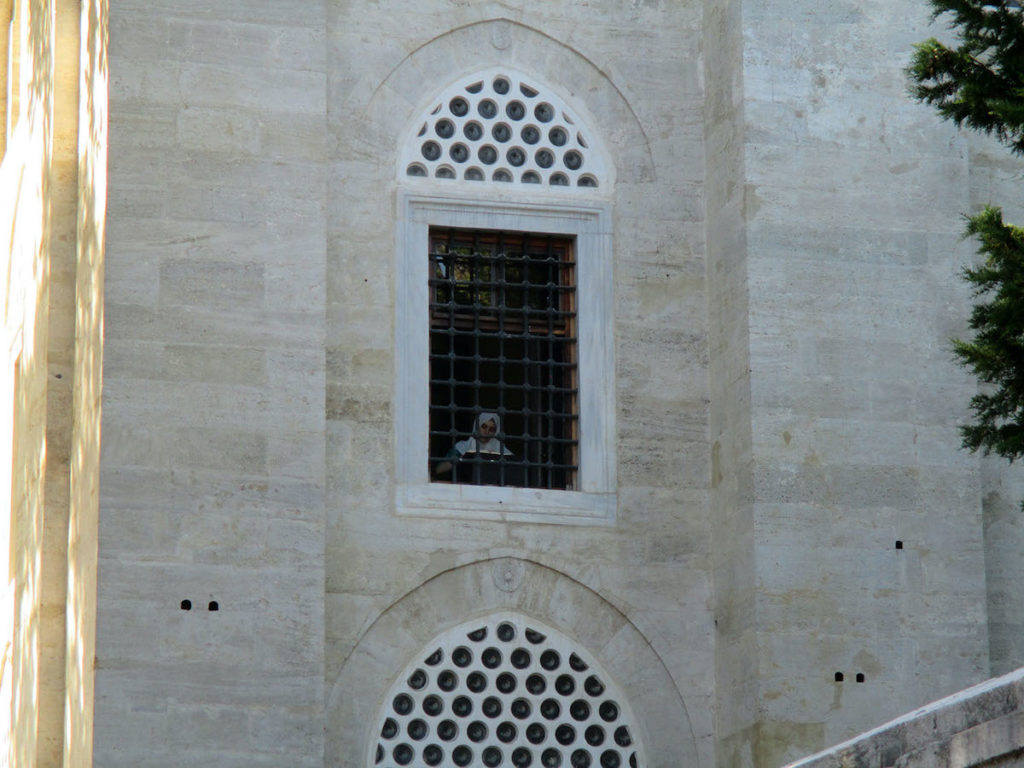
Turning to the diminutive structures themselves, the mosque complex of Yeni Valide, built by the mother of Sultan Ahmed III, Gülnüş Emetullah Sultan, in 1708-1711 in the Asian quarter of Üsküdar, includes a dozen avian sanctuaries.[33] This complex likely boasts the largest collection of bird cavities, houses, kiosks, and palaces, beginning at the entrance portal and encircling the entire outer perimeter of the mosque itself. The stones of the qibla wall, for instance, include numerous cavities, the defective cracks of the building material often upcycled into avian homes rather than discarded as construction refuse.[34] In just one part of this wall, we notice no fewer than five cubbyholes on either side of an open grill window, where a woman sits and reads the Qur’an (Fig. 3). If here and in other cases the mosque is indeed a “finely tuned acoustic instrument,”[35] then its melodies must be considered polyphonous. The symphonic mix absorbs the muezzin’s call to prayer, the imam’s intoned Qur’anic verses, the pious utterances of the faithful (both male and female), and the singsong of birds fluttering in and out of the Ka‘ba-oriented wall.
This vibrant, harmonic mélange captured the attention of de Amicis when he visited the deserted quarters of Constantinople, “whose silence is unbroken save for the flapping of birds’ wings or the guttural cry of a muezzin calling out the word of God from some distant unseen minaret.”[36] The avian and devotional world of man worked in concert, rhapsodizing from stone walls while pulsing soundwaves throughout the polis. This aural intermingling, as Arnold Berleant stresses, proves that there is “no sanctuary from the inclusiveness of nature.”[37]
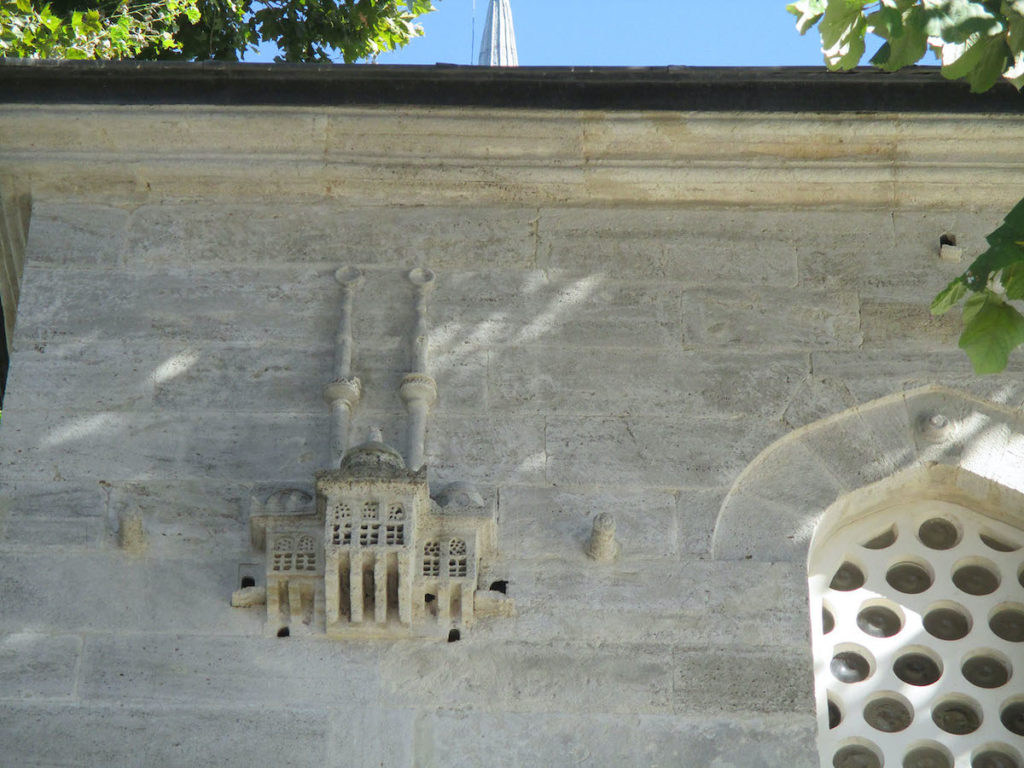
Cubbyholes of the type found in the Yeni Valide qibla wall function as simple “bird abodes” (kuş evi), especially for doves and pigeons. However, in contemporary Turkish scholarship the more elaborate micro-architectural additions are described as “bird kiosks” (kuş köşkleri), “bird palaces” (kuş sarayları), and, more specifically, “swallow palaces” (serçe sarayları). Also at the mosque complex of Yeni Valide, half a dozen birdhouses ornament the gate and the mosque’s walls, ranging from modest cubic structures to highly elaborate architectonic flights of fancy (Fig. 4). The elaborate projections contain numerous cavities in which swallows build their nests and tend to their hatchlings in a comfortable ambient temperature.[38] Birds gain access to these hollows—which look like circular peek-a-boo windows to onlookers at street level—via perches on either side of the avian palace. The perches resemble rounded brackets meant to carry an overhanging element such as a cornice or eave.
As for the miniature bird palaces themselves, their creators freely combined architectural elements, including lattice windows, crenellations, cupolas, and minarets girdled by balustraded balconies and topped with crescent finials.[39] Intriguingly, some birdhouses also display the rounded arch even before the latter motif’s efflorescence on a grander scale in the built environment of Istanbul, where pointed arches held sway until the 1740s.[40] As a result, it appears that stone masons may have used the birdhouse as a miniature model for preliminary architectonic experimentation. These small avian edifices were, after all, sculpted and not built. As architectural models or applied ornaments, they neither bore the vertical weight of masonry nor the lateral thrust of a weighty dome. They offered, then, a free-form arena in which to experiment and play with architectural vocabularies. Put differently, by crafting micro-abodes for winged entities, Ottoman stone masons could master and put on display their sculptural skills and virtuosity while also unleashing a creativity largely unconstrained by the laws of gravity and physics.[41]
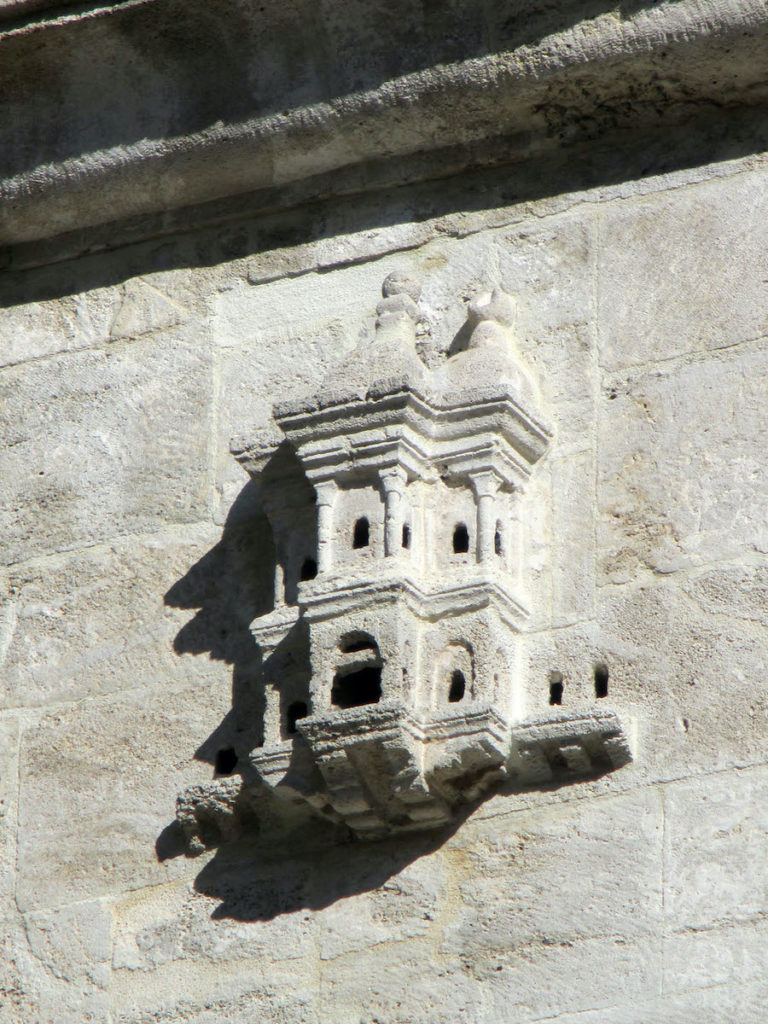
Also located in Üsküdar and built in 1758-1761, by which time the new baroque style had taken hold, the Ayazma mosque complex is famous for its collection of bird palaces (as in Fig. 1). The structure was commissioned by Sultan Mustafa III (r. 1757-1774) in honor of his mother, Mihrişah Kadın, and his older brother, Süleyman, both deceased.[42] Its avian micro-structures remain inhabited today, their long nesting materials laboriously stuffed into hollows and blowing in the wind. Moreover, its bird palaces, including a belvedere-like structure on the entrance gate of the complex (Fig. 5), look like baroque kiosks and pavilions with projecting cornices, staircases, grilled fenestration, Doric columns, turrets, and gabled roofs ornamented with decorative pinnacles. Eclectic in style, these miniature structures seem, in at least one case, to refer to the royal pavilion (hünkar kasrı) that projects from the mosque’s domed prayer hall and thus, in a self-reflexive move, to the Ayazma’s own architectural arrangement.
The Ayazma complex also includes a large cemetery housing the graves of deceased members of the Ottoman elite. The tombstones sometimes include small carved basins that function as drinking troughs for animals—a subject deserving of further scholarly attention.[43] (Today, these concavities collect rainwater, quenching the thirst of street cats, dogs, and birds.) Swallows, sparrows, and other birds tend to assemble in cemeteries since these were—and remain—studded with trees. For the inhumed denizens, cemeteries provide an abode for the humans who are no longer with us; however, for birds they have always served another purpose as eternally living sanctuaries, or himas.
Prominent among Istanbul’s funerary arboreal refuges are the cemeteries and tombs belonging to the Eyüp Sultan Shrine Complex, whose mosque was originally built in 1458-1459 and later leveled and rebuilt in 1798-1800 at the behest of Sultan Selim III (r. 1789-1807). Dedicated to Ayyub Ansari (d. c. 672-674), a companion of the Prophet Muhammad whose relics were “discovered” in this area of the Golden Horn, the Eyüp complex is the sacred heart of Islam in the city. On religious holidays and weekends, pious visitors have for centuries performed pilgrimage, interacted with a blessed stone footprint of the Prophet Muhammad,[44] and paid their respects to the deceased by embarking on funerary promenades in the area.[45]
Writing in the seventeenth century, the Ottoman explorer Evliya Çelebi (d. 1682) described the Eyüp Complex in his Seyahatname (Book of Travels). He notes that it included many gardens, and that the mosque’s courtyards housed mulberry (dut), sycamore (çınar), and other types of trees. He also mentions that herons nested in the sycamore trees of one of the mosque’s courtyards, “gifting” their feathers as dome ornaments.[46] That their presence embellished life and their feathers adorned structures suggest a premodern Muslim avian ethics that is intimately linked with aesthetics, expanding our means to assess what is considered moral and what, beautiful.
Beyond the insights of new materialism, neovitalism, and ecocriticism, one possible theoretical intervention here would be to investigate what Richard Powers calls “species loneliness,”[47] whereby humans are shown to fare much worse at an emotional level if they are not encircled by plants and animals—that is, if they are not unblinded to human exceptionalism. After all, Ottoman birdhouses were neither constructed to gather droppings nor meant to serve as architectural instruments to harvest edible flesh. Rather, they lured birds, their balletic flights, and their tuneful language closer into sight and earshot, thereby breaking the silence, solitude, and solipsism of the human condition.
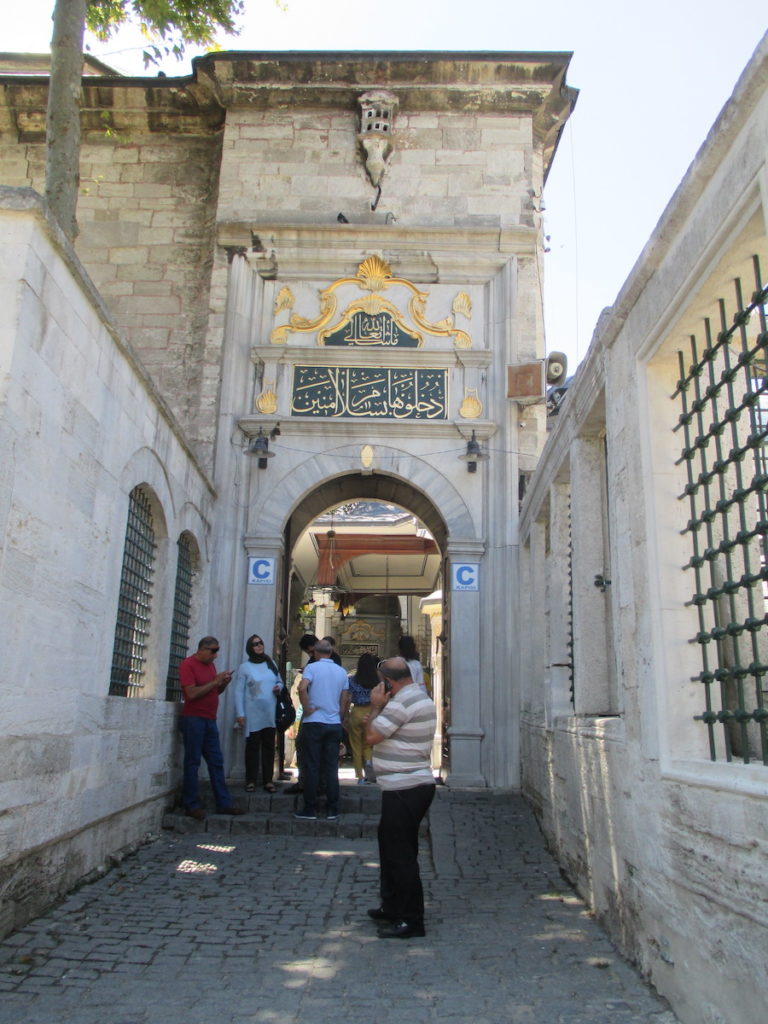
Back in the bustle of Eyüp, the rebuilt mosque of 1798-1800 also includes entrance gates ornamented with inscriptions inviting pilgrims to enter the architectural complex with, “God willing,” peace and faith. Perched above the gilt calligraphy appears a double-storied, curvilinear micro-edifice propped up by a carved console, occupied still today by a couple of pigeons that fly in and out of its six arched hollows (Fig. 6 and Video 1). Their cooing mixes with the chit-chat of pilgrims below as well as with the voices of muezzins and imams amplified by loudspeakers.
Video 1. Pigeons and birdhouse above the entrance portal of the Eyüp Sultan Shrine complex, Istanbul. Video by the author.
Among Ottoman rulers, Sultan Mustafa III (r. 1757-1774) appears to have been the keenest sponsor of birdhouse architecture. Besides the Ayazma Mosque in Üsküdar, he also commissioned a mosque complex in the area of Laleli, which was supported by income generated from the nearby Taşhan (“stone bazaar” or wholesale selling point), the latter including no fewer than five birdhouses and hollows appended to or tucked into its stone- and brickwork.[48] The mausoleum of Sultan Mustafa III, which forms part of the Laleli complex, was likely designed by Mehmed Tahir Ağa, a leading architect of the Ottoman baroque style, and built in 1759-1763.
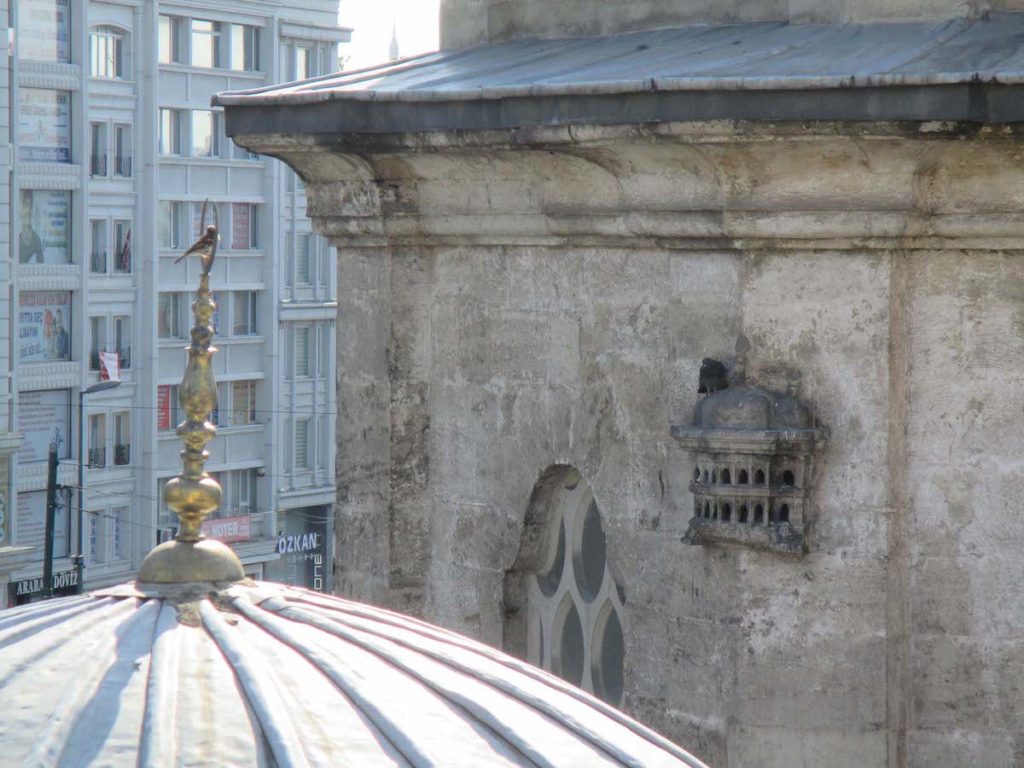
This single-domed octagonal structure includes wide corner pilasters and thick cornices—all baroque features that were perfected at the Nuruosmaniye Mosque a decade prior. Among its roster of architectural ornaments, the sultan’s tomb also displays a prominent birdhouse perched above one of its windows (Fig. 7 and Video 2)—an architectonic reminder of the hadith praising the deceased’s soul as a bird flying into paradise. Its undulating eaves and polylobed arches partake in international baroque aesthetics, while its crevasses continue to serve a local avian population in Istanbul until the present day. Here and elsewhere, it becomes clear that the baroque style cannot be pinned to one geographical locale, type of structure, or, for that matter, one genus of living species.
Video 2. Birds and birdhouse at the Tomb of Sultan Mustafa III, Istanbul. Video by the author.
Building Bonds, Trading Places
As Ünver Rüstem has shown, the Ottoman baroque style aimed for variety as a key desideratum. Such innovation in the architectural field included manipulations of a global repertoire of form and ornament as well as creative responsiveness to local modes of artistic expression, including the city’s Byzantine past.[49] Additionally, architects wished to build structures that were graceful, harmonious, and masterly—in sum, elegant (hoş-ayende).[50] As charming micro-structures, birdhouses appear to concretize the adjective hoş-ayende insofar as they are awe-inspiring in their minuteness and delightful in their panoply of decorative features.
The connection between aesthetics and ethics also calls into question the framework of inquiry guiding today’s discourses on animal rights. Instead, Ottoman birdhouses suggest a different model of human-animal relations based on bonded responsibility and ricocheted joy. Where birds are gifted well-protected domiciles, humans luxuriate in sweet-sounding melodies. This transaction is not an instrumental one but rather reciprocally altruistic; it is based on sympathy, gratitude, and trust in partnership within a particular social and ecological environment.[51] Avian micro-architecture therefore provides an occasion for reciprocal care-taking and mutual felicity, a harmonious and graceful balance that is in turn captured by the Ottoman baroque architectural term hoş-ayende.
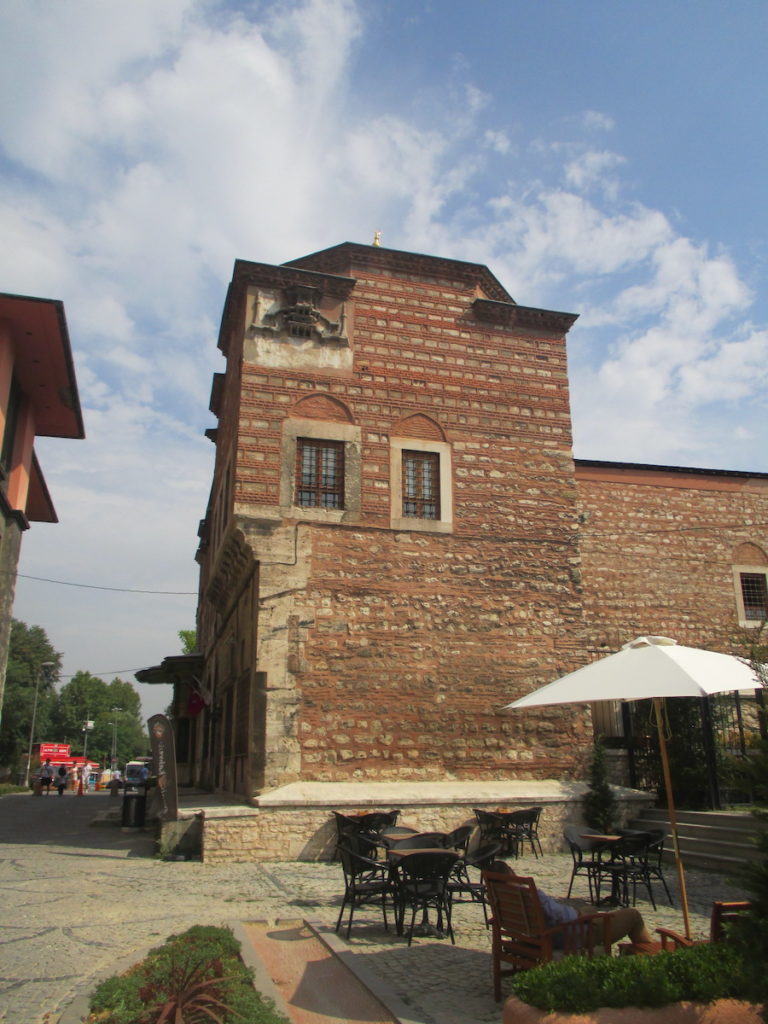
One final exuberant birdhouse example, which bespeaks these bonds, ornaments the Seyyid Hasan Paşa madrasa complex located in the Istanbul neighborhood of Beyazıt. Attributed to the chief architect Mustafa Ağa and constructed in 1745-1747, the complex—a rectangular two-story edifice—includes a large birdhouse at the corner that contains the madrasa’s accompanying mosque, a small chamber without a minaret (Figs. 8 and 9).[52] Tucked under the pointed brickwork supporting the building’s roof, this avian micro-structure is monumental in its conception. Albeit rendered on a reduced scale, muscular minarets tower on either side of the central structure, connecting to it through double ramps or staircases that recall those found in the Ottoman baroque mosque complexes built by the empire’s contemporary rulers.[53] It thus suggests that its patron wished to stamp his complex with the image of a fictive imperial mosque.
For its part, this “bird mosque” includes intricately pierced windows, putting on full display the mason’s command of complex geometric patterns. The stone filigree work could have helped visualize three-dimensional designs or it could have served as a zone of experimentation to refine accuracy of execution, as had been the case for architectural models since the fifteenth century.[54] The maquette levitating in Beyazıt, however, is not the preliminary rough sketch of man; it is the final dwelling place of birds.
This micro-architectural avian habitat may have served as a reminder of one of the services provided by the nearby mosque complex of Beyazıt II (1501-1506), which is clearly articulated in its endowment deed and described in a Turkish-language secondary source as follows:
A sum of thirty gold sovereigns was allocated to be spent each year on feeding “birds which were permanent residents of the mosque.” Rice and millet were provided for the birds, bread for the dogs. There was a person responsible for feeding the animals, treating those that were sick and binding up broken bones.[55]
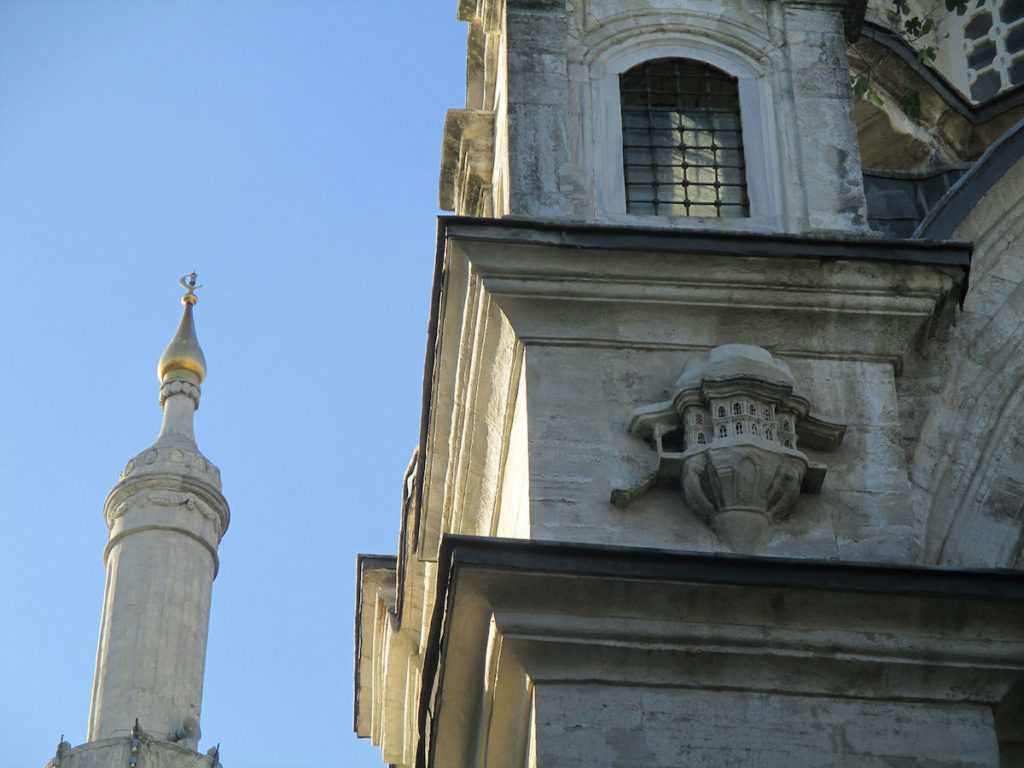
Along with the financial support that allowed for food allocations and a salaried individual to tend to wounded animals, the deed also refers to the birds as the “mosque’s inseparable residents.”[56] This descriptor is remarkable, especially in light of the fact that scholars have tended to describe mosques as the “places where men pray together,”[57] as the crowning achievement of human intelligence and skill. While this may hold true, Ottoman textual sources and architectural practices make it patently clear that mosques were also made to house avian congregations, which were not occasional or bound by prayer times. In this reversal of roles, it is man who becomes incidental and migratory, ceding this most sacred of spaces in Islam to birds, as their own inalienable property (Fig. 10).
And yet estates do not last forever. In Istanbul and throughout the Ottoman realm, birdhouses waned during the nineteenth century. This reduction in avian microarchitecture reveals the eighteenth century as a period of dynamic architectural experimentation through the crafting of small-scale structures that nurtured a oneness of being. At the same time, such birdhouses reifed an anxiety about the city’s rapid encroachment onto nature and the loss of eco-systems sustaining of animal life—a fragile balance that endures into the present moment.
Christiane Gruber is Chair and Professor of Islamic art in the History of Art Department at the University of Michigan, Ann Arbor.
[1] Edmondo de Amicis, Constantinople (Philadelphia: Henry T. Coates & Co., 1896), 164.
[2] There exist a number of studies on Ottoman birdhouses, inter alia: Şebnem Eryavuz, “Kuşevi,” İslâm Ansiklopedisi; Cengiz Bektaş, Kuş Evleri / Bird Houses (Istanbul: Arkeoloji ve Sanat Yayınları, 2011); Orhun Barışta, Osmanlı İmparatorluğu Dönemi İstanbul’unda Kuşevleri (Ankara: T.C. Kültür Bakanlığı, 2000); and Mehmet Aycı, ‘Şefkat Estetiği’: Kuşevleri (Istanbul: Zeytinburnu Belediyesi, 2010).
[3] Lemi Ş. Merey, “Kuşevleri ̶ Serçesarayları,” in Fifth International Congress of Turkish Art, ed. Géza Fehér (Budapest: Akadémiai Kiadó, 1978), 605; and Hande Sanem Çinar and Funda Yirmibeşoğlu, “The Architecture of Fauna in Turkey: Birdhouses,” Current Urban Studies 7 (2019), 552.
[4] For the most recent and thorough discussion of Ottoman baroque architecture, see Ünver Rüstem, Ottoman Baroque: The Architectural Refashioning of Eighteenth-Century Istanbul (Princeton: Princeton University Press, 2019).
[5] Sahih Muslim, Book 53, Hadith 31, https://sunnah.com/muslim/53/31. There exist numerous other hadiths that refer to birds as representing the souls of believers and martyrs, embodying the provision of God, etc.
[6] On microarchitecture functioning as scriptural exegesis and enabling the fulfilment of paraliturgical devotions, see Achim Timmermann, “Micro-architecture,” in Grove Art Online (2012), https://doi.org/10.1093/gao/9781884446054.article.T2216986. Besides the “baroque” elements of late Ottoman birdhouses, scholars of European art also have stressed the “Gothic” features of microarchitecture. On this topic, see François Boucher, “Micro-Architecture as the ‘Idea’ of Gothic Theory and Style,” Gesta 15 (1976), 71-89.
[7] On mosques as Qur’anic “sound boxes,” see Nina Ergin, “The Soundscape of Sixteenth-Century Istanbul Mosques: Architecture and Qur’an Recital,” Journal of the Society of Architectural Historians 67:2 (2008), 204.
[8] On interspecies relations more broadly, see Donna Haraway, When Species Meet (Minneapolis: University of Minnesota Press, 2008).
[9] On the dovecotes (güvercinlik) of Cappadocia, see, among others, Yavuz İşcen, “Kapadokya ve güvercinlikler,” Amfora Cappadocia Dergisi 1 (2004), 30-34; and Rahşan Özen, “Bird Shelters in Turkey: Birdhouses and Dovecotes,” Kafkas Üniversitesi Veteriner Fakültesi Dergisi 18/6 (2012), 1081. On the pigeon towers (kabutarkhana) of Iran, see Elisabeth Beazley, “The Pigeon Towers of Isfahan,” Iran 4 (1996), 105-109; Amin Saeidian et al, The Vernacular Iranian Architecture: The Collection of Asbads, As Anbars, Ice Houses, Pigeon Houses and Watermills of Iran (np: Lambert Academic Publishing, 2012), 75-88, which largely reiterates Aryan Amirkhani et al, “Isfahan’s Dovecotes: Remarkable Edifices of Iranian Vernacular Architecture,” Middle East Technical University – Journal of the Faculty of Architecture 26/1 (2009), 177-186.
[10] On birds as praising God and on bird language (mantiq) as discussed in the Qur’an, see Sarra Tilli, Animals in the Qur’an (New York: Cambridge University Press, 2012), 175-185.
[11] For a further discussion of the hima as a “living sanctuary” along with its intersection with environmental ethics and an Islamic “harmonic” worldview, see Mohd Zuhd bin Marsuki, “The Practice of Islamic Environmental Ethics: A Case Study of Harim and Hima,” Ph.D. dissertation, University of Wales, 2009.
[12] Félix Guattari, Chaosmosis: An Ethico-Aesthetic Paradigm, trans. Paul Bains and Julian Pefanis (Bloomington: Indiana University Press, 1995).
[13] Ibrahim Abdul-Matin, Green Deen: What Islam Teaches about Protecting the Planet (San Francisco: Berrett-Koehler Publishers, 2010), 5. On these concepts, also see Anna Gade, Muslim Environmentalisms: Religious and Social Foundations (New York: Columbia University Press, 2019), 78-95.
[14] William Chittick, “Wahdat al-Wujud,” in Encyclopedia of Islam and the Muslim World, ed. Richard Martin, 2 vols. (New York City: Macmillan, 2004), 2:72; and Alexander Knysh, Ibn ‘Arabi in the Later Islamic Tradition: The Making of a Polemical Image in Medieval Islam (Albany: State University of New York Press, 1999).
[15] K.A.C. Creswell, A Short Account of Early Muslim Architecture (Aldershot: Scolar, 1989), 364-367.
[16] Ibn al-Zubayr, The Book of Gifts and Rarities, trans. Ghadah Hijjawi Qaddumi (Cambridge, MA: Harvard University Press, 1996), 154; also see Alastair Northedge, “An Interpretation of the Palace of the Caliph at Samarra (Dar al-Khilafa or Jawsaq al-Khaqani),” Ars Orientalis 23 (1993), 143-170.
[17] For a further discussion of awe (‘ajab) as it pertains to Abbasid luster ceramics, see Matthew Saba, “Abbasid Lusterware and the Aesthetics of ‘Ajab,” Muqarnas 29 (2012), 198.
[18] On these subjects, see the essays by Gilles Veinstein and Hedda Reindl-Kiel in Suraiya Faroqhi (ed.), Animals and People in the Ottoman Empire (Istanbul: Eren, 2010).
[19] Selçuk Esenbel, “Of Birds and Diplomacy: Royal Gifts to Sultan Abdülhamid II,” in Faroqhi, Animals and People in the Ottoman Empire, 287-292. This study is devoted to an 1892 gift package offered to the Ottoman sultan by Yamada Torajiro, an unofficial Japanese envoy. Gifts included martial objects related to Samurai culture, wooden goods, thirty persimmon trees, and rare birds, including a pheasant, robin, and Japanese nightingale. In return, Abdülhamid II offered a horse to Tarajiro.
[20] Diren Çakılcı, “Sultan II. Abdülhamid’in Hayvan Merakı: Yıldız Sarayı’nda Kuşluk-i Hümâyûn Teşkilatı,” Turkish Journal of History 68 (2018), 57-100.
[21] Başbakanlık Osmanlı Arşivi, Istanbul, Y.PRK.SGE.2-82 (H-30-12-1303): Yıldız Sarayı ile kasırların kuşluklarında mevcut kuş ve hayvanların cins ve miktarını gösterir defter, 1880s.
[22] Nina Ergin, “‘Praiseworthy in that Great Multitude was the Silence’: Sound/Silence in the Topkapı Palace, Istanbul,” in Resounding Images: Medieval Intersections of Art, Music, and Sound, ed. Susan Boynton and Diane Reilly (Turnhout: Brepols, 2015), 118.
[23] Ergin, “‘Praiseworthy in that Great Multitude was the Silence’,” 126; and Gülru Necipoğlu, Architecture, Ceremonial, and Power: The Topkapi Palace in the Fifteenth and Sixteenth Centuries (Cambridge, MA: MIT Press, 1991), 123.
[24] Online English translation of Ibn Sina’s Risalat al-Tayr available on al-Kashkul.
[25] Yumiko Kamada, “The Mantiq al-Tayr (Language of the Birds) of 1487,” in Heilbrunn Timeline of Art History (New York City: The Metropolitan Museum of Art, 2000); and for the most recent English translation of the Mantiq al-Tayr, see Sholeh Wolpé, The Conference of the Birds (New York: W. W. Norton & Company, 2017).
[26] Hanife Koncu (trans. Suraiya Faroqhi), “Doves/Pigeons in Turkish Classical Poetry,” in Faroqhi, Animals and People in the Ottoman Empire, 99-112; on “love-crazed nightingales,” see Shirin Hamadeh, The City’s Pleasures: Istanbul in the Eighteenth Century (Seattle and London: University of Washington Press, 2008), 190; and on the dove in modern Turkish poetry, see Laurent Jean Nicolas Mignon, “The Beloved Unveiled: Continuity and Change in Modern Turkish Love Poetry (1923-1980),” Ph.D. dissertation, School of Oriental and African Studies, University of London, 2017, 72.
[27] E. J. W. Gibb, The Poets and Poetry of Turkey (Washington and London: Walter Dunne, 1901).
[28] Michel de Montaigne, “Of Cruelty,” 191-192; also see Richard Foltz, Animals in Islamic Tradition and Muslim Cultures (Oxford: Oneworld, 2006), 5.
[29] Malik Aksel, “Eski İstanbul’da Kuş Evleri ve Kuşlar,” Türk Folklor Araştırmaları 11/225 (1968), 4722. Aksel mentions a crane (leylek/laklak) hospital in the city of Bursa, where cranes, crows, and other destitute or wounded animals would be tended to and looked after. For further information about this animal hospital, see Ahmet Haşim, Gurabahane-i Laklakan (Istanbul: Dergâh Yayınları, 1991).
[30] In Egypt, minarets also could include ornaments that functioned as animal food bowls as well. For example, the mosque of Ibn Tulun included a boat-shaped finial (‘ushari) surmounting the original minaret, which was replaced with a crescent in 1892 when it was blown away in a windstorm. The minaret boat finial was ten feet long and kept full of grain all year round to attract sparrows. See M. Tarek Swelim, “The Minaret of Ibn Tulun Reconsidered,” in The Cairo Heritage: Essays in Honor of Laila Ali Ibrahim, ed. Doris Behrens-Abouseif (Cairo and New York: American University in Cairo Press, 2000), 88. Illustrations of the grain-bowl boat finial were made by Pascal Coste and also included in Prisse d’Avennes.
[31] de Amicis, Constantinople, 164-165.
[32] Merey, “Kuşevleri ̶ Serçesarayları,” 608; and Çinar and Yirmibeşoğlu, “The Architecture of Fauna in Turkey,” 553.
[33] The architect of the complex (külliye) is believed to be Kayserili Mehmed Ağa (Tülay Sezgin Orman, “Yeni Vâlide Külliyesi,” İslâm Ansiklopedisi); also see Aras Neftçi, “18. Yüzyıl Kuşevleri,” in Semra Ögel’e Armağan: Mimarlık ve Sanat Tarihi Yazıları (Istanbul: Ege Yayınları, 2000), 96-97.
[34] Özen, “Bird Shelters in Turkey,” 1080; and Merey, “Kuşevleri ̶ Serçesarayları,” 607.
[35] Ergin, “The Soundscape of Sixteenth-Century Istanbul Mosques,” 215. Here, Ergin refers to the sound vessels lodged within the mosques, which function as Helmholtz resonators that reradiate sound in a hemispherical direction.
[36] de Amicis, Constantinople, 68.
[37] Arnold Berleant, The Aesthetics of the Environment (Philadelphia: Temple University Press, 1996), 8.
[38] Çinar and Yirmibeşoğlu, “The Architecture of Fauna in Turkey,” 554.
[39] Ünver Rüstem, “From Auspicious Ornament to State Symbol: The Crescent Moon in Ottoman Art and Architecture,” in The Moon: A Voyage Through Time, ed. Christiane Gruber (Toronto: Aga Khan Museum, 2019), 45-55.
[40] Rüstem, Ottoman Baroque, 64.
[41] See Johan Huizinga, Homo Ludens: A Study of the Play-Element in Culture (Boston, MA: Beacon Press, 2014).
[42] Semavi Eyice, “Ayazma Camii,” İslâm Ansiklopedisi; and Rüstem, Ottoman Baroque, 172.
[43] Anonymous, “Türk Mimarîsinin Minyatür Yapıları: Kuş Evleri,” Stratejik Operasyon: Tarih.
[44] On this and other stone footprints of the Prophet, see Christiane Gruber, “The Prophet Muhammad’s Footprint,” in Ferdowsi, the Mongols, and the History of Iran: Art, Literature and Culture from Early Islam to Qajar Persia, ed. Robert Hillenbrand, Andrew Peacock, and Firuza Abdullaeva (London: I.B. Tauris, 2013), 297-305.
[45] The expression “funerary promenade” is inspired by Roya Marefat, “Beyond the Architecture of Death: The Shrine of Shah-i Zinda in Samarqand,” Ph.D. dissertation, Harvard University, 1991.
[46] Semavi Eyice, “Eyüp Sultan Külliyesi,” İslâm Ansiklopedisi. Also see Mehmet Nermi Haskan, Eyüp Tarihi, 2 vols. (Istanbul: Türk Turing Turizm İşletmeciliği Vakfı, 1993), 1:49-53, 180-186.
[47] David Wallace-Wells, The Uninhabitable Earth: Life After Warming (New York: Penguin, 2019), 215.
[48] Taşhan is also known as Sipahiler, Çukurçeşme, and Katırcıoğlu Hanı. It consists of two stories and its basement was used as a barn. Ahmet Vefa Çobanoğlu, “Lâleli Külliyesi,” İslâm Ansiklopedisi; and Ceyhan Güran, Türk Hanlarının Gelişimi ve İstanbul Hanları Mîmârisi (Ankara: Vakıflar Genel Müdürlüğü Yayınları, 1978), 138-139.
[49] Rüstem, Ottoman Baroque, 211, 274.
[50] For the term hoş-ayende, see Rüstem, Ottoman Baroque, 186; and for a further discussion of the eighteenth century as a period of joyous gatherings and sensuous delights, see Hamadeh, The City’s Pleasures.
[51] Robert Trivers, “The Evolution of Reciprocal Altruism,” The Quarterly Review of Biology 46:1 (1971), 35-57.
[52] Ahmet Vefa Çobanğolu, “Seyyid Hasan Paşa Külliyesi,” İslâm Ansiklopedisi.
[53] Rüstem, Ottoman Baroque, 131.
[54] Gülru Necipoğlu, “Plans and Models in 15th– and 16th-Century Ottoman Practices,” The Journal of the Society of Architectural Historians 45:3 (1986), 236, 240.
[55] Bektaş, Kuş Evleri / Bird Houses, 13; and Merey, “Kuşevleri ̶ Serçesarayları,” 607.
[56] Unfortunately, the original text, most likely written in Arabic, is not provided by Turkish scholars and is not currently available to me. The Turkish-language iteration of “the mosque’s inseparable residents” given by Bektaş is caminin ayrılmaz sakinleri.
[57] Paul Wheatley, The Places Where Men Pray Together: Cities in Islamic Lands, Seventh through Tenth Centuries (Chicago: Chicago University Press, 2001).
Cite this article as: Christiane Gruber, “Like Hearts of Birds: Ottoman Avian Microarchitecture in the Eighteenth Century,” Journal18 Issue 11 The Architectural Reference (Spring 2021), https://www.journal18.org/5689.
License: CC BY-NC
Journal18 is published under a Creative Commons CC BY-NC International 4.0 license. Use of any content published in Journal18 must be for non-commercial purposes and appropriate credit must be given to the author of the content. Details for appropriate citation appear above.

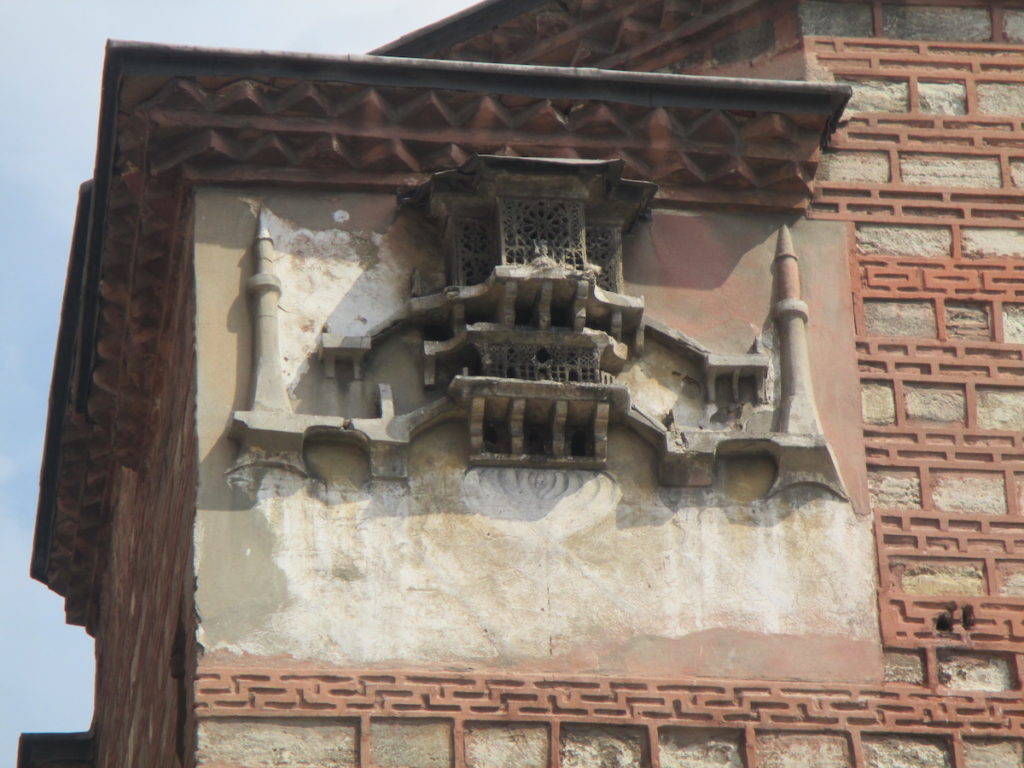
Pingback: Η Κοζάνη, ο οθωμανοτουρκικός πολιτισμός και τα τζιουρτζιούφια (μέρος β´). Γράφει ο Νίκος Σταμκόπουλος* | Εφημερίδα Κοζάνη | Ειδήσεις και ενη
Pingback: Η Κοζάνη, ο οθωμανοτουρκικός πολιτισμός και τα τζιουρτζιούφια (μέρος γ´). Γράφει ο Νίκος Σταμκόπουλος* | Εφημερίδα Κοζάνη | Ειδήσεις και ενη
Pingback: Η Κοζάνη, ο οθωμανοτουρκικός πολιτισμός και τα τζιουρτζιούφια. Γράφει ο Νίκος Σταμκόπουλος - Ο Χρόνος : xronos-kozanis.gr